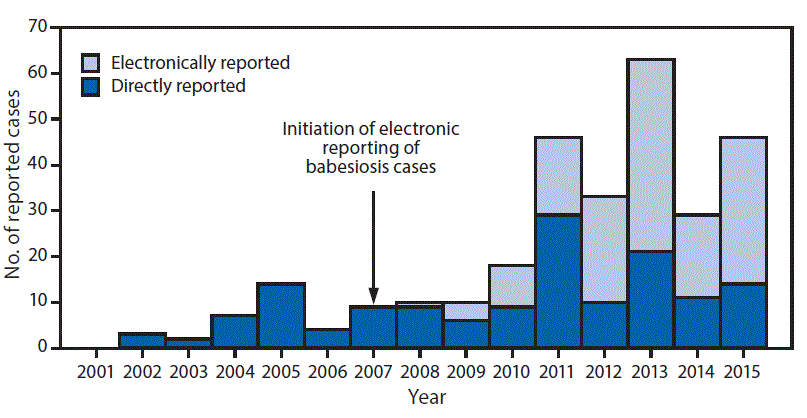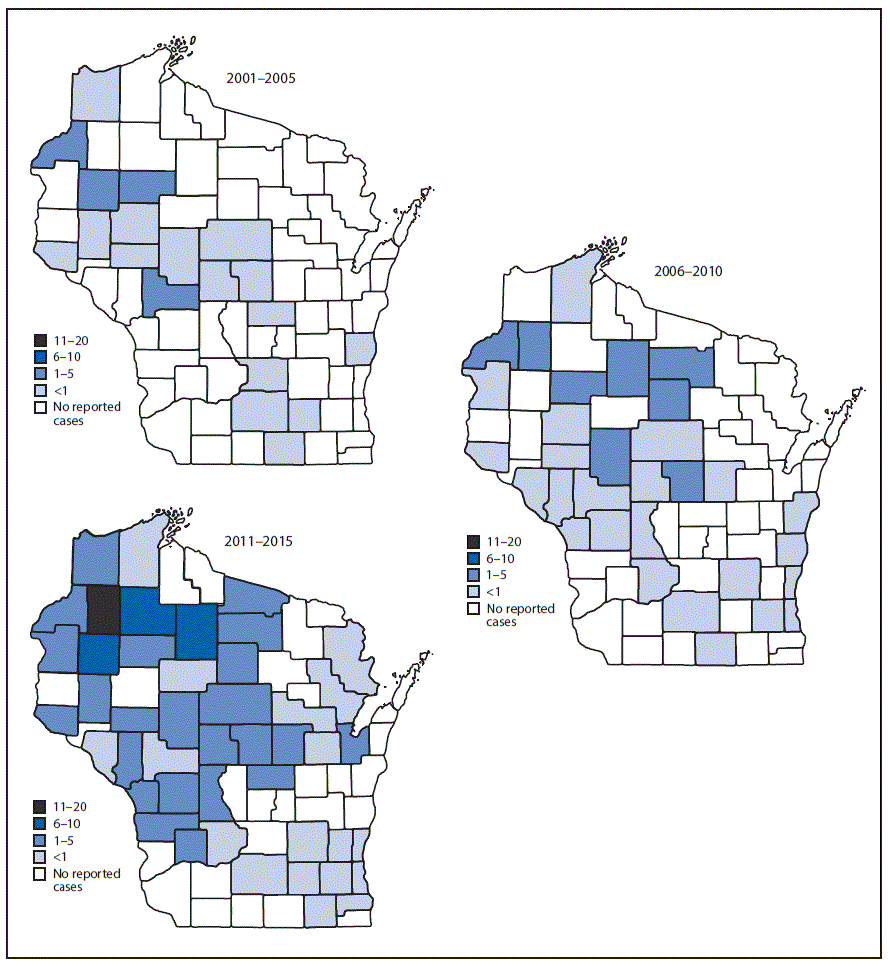It is not just a bad summer for ticks — it has been a bad decade for the spread of tick-borne infections. New surveillance from the CDC reports rapid expansion and increase in cases of babesiosis, a sometimes life-threatening disease, in Wisconsin.
The CDC compiled the new report from surveillance conducted every three years during the period between 2001 through 2015. During that time, electronic surveillance came online to provide faster, more thorough, case reports. While a boost in case counts as monitoring methods improve is sometimes due to under-reporting, the CDC says the increase in Wisconsin is due to an actual uptick in cases — not just better reporting.

Total confirmed babesiosis case counts (N = 294) initially reported directly and electronically through the Wisconsin Electronic Disease Surveillance System (WEDSS),* Electronic Laboratory Report (ELR) — Wisconsin, 2001–2015.
What Is Babesiosis and Why Should You Be Concerned?
The black-legged tick Ixodes scapularis transmits the Babesiosis bacteria. This is the same tick that spreads Lyme disease, anaplasmosis, and recently the more immediately deadly Powassan virus.

These ''black-legged ticks'', Ixodes scapularis, are capable of spreading babesiosis, Lyme disease, anaplasmosis, and Powassan disease, this small arthropod packs powerful poison.
Babesia microti, a relative of the parasite that causes malaria, causes the babesiosis infection. While some people have no symptoms when infected, in others, the illness can be fatal. Symptoms of babesiosis include fatigue and weakness, nausea, diarrhea, and often a high fever. More severe complications include kidney damage and heart failure.
Because babesiosis is spread by I. scapularis, the geographic range of the infection is expanding along with the tick. While ticks are the agent, or "vector," that spreads the bacteria, rodents like white-footed mice are the reservoir culprits who carry the disease. Ticks are infected when they feed on mice, and in turn, ticks infect white-tailed deer, that then become the primary hosts for tickborne infections carried by black-legged ticks.

The blacklegged tick (Ixodes scapularis) is widely distributed in the northeastern and upper midwestern United States.
Here are some of the findings of the new babesiosis report:
- The length of time between infection to symptoms can be about two weeks, with 96% of cases reported between April and October.
- Between 2001 and 2015, there were 430 cases reported in Wisconsin. Of those, laboratory testing confirmed 68%. For the victims with confirmed cases, 158, or 65%, were hospitalized, and three people died as a result of the infection.
- Of the 108 patients with probable babesiosis, 24% were hospitalized, and none died.
- Wisconsin did not begin screening its blood supply for the babesiosis parasite until 2016. Before that, three cases of the infection spread through transfusion with contaminated blood.
The threat is rising. Between the years of 2001–2003 and 2004–2006, there was a 400% increase in the mean annual incidence of babesiosis cases. The rate rose incrementally after that until it jumped again between 2007–2009 and 2010–2012 with a 235% increase.
Overall, the incidence rose 2600% between 2001–2003 (o.03 mean annual incidence) and 2013–2015 (0.80 mean annual incidence).

Number and incidence of reported confirmed babesiosis cases by 3-year interval and percentage confirmed using polymerase chain reaction (PCR) — Wisconsin, 2001–2015. Mean annual incidence is the average number of cases per 100,000 residents in a single year.
The number of counties reporting the incidence of babesiosis rose from 20 to 46 between 2011 and 2015.

Geographic distribution of confirmed cases of babesiosis per 100,000 residents by county of residence — Wisconsin, 2001–2005, 2006–2010, and 2011–2015
This report and physical observations of ticks on hunter-harvested deer, support the finding that the range of the black-legged tick has expanded rapidly, and will continue to do so with a warming climate and clearance of forest stands. As essential the ticks, so go the infections they transmit to humans.
Study authors write: "Babesiosis cases in Wisconsin are increasing in number and geographic range. These trends might be occurring in other states with endemic disease, similar suburbanization, and forest fragmentation patterns, and warming average temperatures."
If you have reason to believe a tick could have bitten you, and experience symptoms, contact your doctor. Prompt treatment is important. The best defense to tick infection is offense — use repellent containing DEET, stay clear of tick territory, wear long sleeves, and pants — and most important, shower and check for ticks each time you return from time in the wild — or just your backyard.
With warming temperatures, ticks are getting worse — readiness is the best way for you, and family members, to avoid infection.
- Follow Invisiverse on Facebook and Twitter
- Follow WonderHowTo on Facebook, Twitter, Pinterest, and Google+
Cover image by George Healy/CDC

























Comments
Be the first, drop a comment!